![]()
![]()
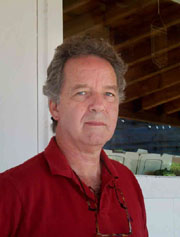
Photo by Isabel Barton
A.T. Mann: Miraculous Methods
An Interview by Peter Barton
Originally published in the December, 2000 issue of The Artful Mind: Berkshires' Monthly Artzine
Photograph by Isabel Barton, Original Images by A T Mann
A.T. (Tad) Mann suggests that there are transcendent principles passed down from the higher ancient civilizations that harmonize the fundamental needs of mankind with the forces of the universe. He further proposes that demystifying secret teachings and advancing timeless methods through modernist discoveries in arts and sciences will organize a citizenry enlightened not to global awareness alone, but intimate individual experience with the central reality of the metaphysical universe.
In more than twelve books, this author exposes the dangers of contemporary educational values that encourage false impressions of ancient teachings and practices because they conflict with present modes. His aim is to expose, to explore, and ultimately to refresh the thinking and application of these ancient methods in the clear light of modern living.
Peter Barton: I recall from our undergraduate days in Ithaca that you have roots here in the Hudson Valley and in the city of Hudson in particular.
A.T. Mann: As it turns out, my ancestors came to this area in the 1700s and one of my great, great grandfathers was the first pastor of the Old Dutch Reform Church in Claverack. I can find any number of headstones with family names on them in the churchyard, as you know because you visited there with me recently. My grandmother and grandfather were both born here in the 1880s, and my mother was born here in Hudson in 1920. We used to come back to Claverack and Philmont for holidays during the 50s. Iíve lived in Europe for almost 30 years so I havenít been back here in quite some time.
PB: You left Cornell University with a degree in Architecture in 1966 and went to Manhattan to work with a prominent firm, but it didnít take. You did design work on several important buildings, but soon left on a "journey to the East." What was that about?
ATM: Even while working in New York I spent a year in Italy in 1968 working for the Architectís Collaborative, which was a firm based in Cambridge, Massachusetts, started by Walter Gropius. I really began to get the European tradition in my bones, in a way, and to enjoy the openness that existed there, vis a vis the way one could express ideas. A little later I became involved in the movement of the sixties, which caused dramatic reassessment of where I was going in terms of my career as an architect, but also on spiritual and esthetic grounds. I began being drawn more and more to the East and Eastern philosophy, which led me to read Jungian Psychology and Eastern Mysticism. This awakening sensibility culminated in the journey around 1970-72. I lived in Morocco and traveled overland to India.
PB: I recall you came to my farm in Sheffield, Massachusetts after your return. You had a glazed-over demeanor and lots of experiences to talk about concerning a personal cultural evolution of the self, you might say.
ATM: This was a very powerful experience for many reasons. In some ways I feel that for the last 28 years Iíve been working through the legacy of experiences I had from that time. Powerful in the sense that I realized I had been very much functioning from my head, which my Cornell education encouraged, if not required. I discovered that there were other levels of being which were just as important, if not more important, like higher intellectual, emotional, and spiritual domains. I began focusing a lot of energy in that direction. Indeed, as I traveled I began painting mandalas, which are circular diagrams, reflections of the psyche, which are instrumental in meditation and in Yoga. These are meant to function as a center for concentration. Simultaneously, of course, I was learning astrology. I spent a number of years living in very primitive places, and realized how powerful the movement of the planets and the stars actually is and began recognizing astrology as a psychic gradient between architecture and social integration; this because I had always been interested in proportion systems used in architecture. If you consider architecture as a three dimensional object that you walk through in a fourth dimension of time, you can view astrology as a fourth and fifth dimensional pursuit. I merely began applying these same proportional systems, the Golden Section for one, to the development of time through peopleís lives.
PB: Books like Sacred Architecture, Sacred Sexuality, The Round Art, Life Time Astrology, et al, probably a half-million books in print, not to mention your own Mandala Astrological Tarot and countless painting and print images of one sort or another. How personal were these pursuitsóor were you just fiddling with the miraculous?
ATM: Iíve done 12 books over the past 26 years. Iíve been very lucky, particularly being in England through the early years, because Iíve been able to write and have books published about my ideas, about my philosophical, astrological, and architectural theories, which are quite radical, even outside of the mainstream in the alternative world. In many ways, I see these books as a kind of cosmology in a sense, of searching to find my roots and coming to the understanding that my roots are in the cosmos. Astrology was a way of locating myself in space and time and it served that purpose very admirably in all of the years since. Many of my early books talk specifically about a very unusual astrological system that I invented that has a biological dimension as well as a psychological and spiritual dimension. Itís also unique because it takes an individual back to when they were conceived. But these astrological ideas are still perceived as very much ahead of their time and quite radical. So I began writing books about other more adventurous subjects, the last two of these were Sacred Architecture and Sacred Sexuality.

Spiralling Solar System in Time, from "The Round Art" (1979)
PB: If I am to understand correctly, across your first books you postulated two theories unique to the astral arts: in the first case prenatal influences are extremely insightful; and in the second case the solar system has a spiraling quotient, a spin gradient. If the earlier method could be seen as Newtonian with its cogs and wheels and dials, you have extended the astral field toward Relativity, considering motion dimensions and energy emotionóin that sense dramatically revved-up the chart reading.
ATM: This is an interesting issue, which is still controversial in Astrology. We all imagine the sun sitting in space with the planets revolving around it in orderly ellipses and circles. Yet in reality the sun moves a tremendous distance óthree quarters of a million kilometers each day; the sun moves rapidly through time and space as the planets moving around it create a series of harmonic spirals. And the image of this diagram has been an image which has informed not only a lot of my architectural ideas and my astrological ideas, but are also something that I felt I needed to represent artistically and esthetically in order to understand them adequately. This had been a primary motif in many of my books. Iíve not only written these books, I have also illustrated and designed graphics for them. The reason being that, for me, the imagery, the graphics, and the symbolism of these subjects is almost as powerful as the words one uses to describe them. So, over the years Iíve really married many of my early interests of, you know, drawing, painting, and particularly geometric imagery into a number of different forms.
The High Priest Tarot Card, from"The Mandala Astrological Tarot" (1987)
PB: One of these forms is Tarot.
ATM: I designed and painted a tarot deck in 1972, which was published by Harper & Row here in the United States in 1987. Again, itís an attempt to recreate a method of ancient science in a modern guise. The "Mandala Astrological Tarot" comprises mandala images, circles within square cards that represent a series of inner landscapes, so that when you select a tarot card, instead of a traditional drawing of a Magician, in my deck you draw the environment of the Magician, in fact you put yourself in the Magicianís world, so in effect you become a magician yourself. In that way I think itís important with these ancient pursuits, many of which arenít taken very seriously in the modern world. I believe that there is a very powerful and fundamental magic which they carry, and I think the language of that magic is certainly symbolism. And itís symbolism that ties astrology, architecture, Tarot and sexuality together.
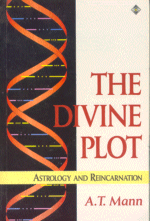
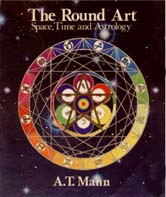
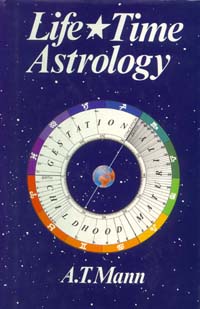
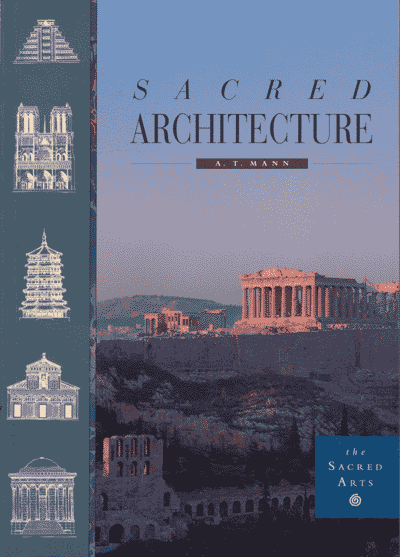

PB: Your books are all very scholarly, which makes me wonder about the modern structure of your thinking. You are not a recluse or an escapist but in the contemporary world in contemporary form, not walking around in ancient costume ó at least not in your public appearance. But two issues come to mind in this matter, the first are you an astrological theorist or are you engaged in the profoundly intimate give and take of the applied miraculous methodology, that is astrological readings and forecasting and client practice?
ATM: Iíve practiced astrology regularly since 1972. I am a member of an international community of serious astrologers; and we are making a very strong effort through publishing books, education, and through various other channels to re-imagine astrology as a modern, contemporary and relevant pursuit. The form that this has taken primarily is the integration of psychology with astrology: most modern astrologers, myself included, have psychological training and work as much as therapists as we do as astrologers. I have many clients all over the world. I travel extensively. Iíve been to Europe three times this year already. Astrology is very much alive and itís a very, very powerful and immediate medium in which to communicate. Indeed, my perception of what astrology is has changed dramatically over the years because initially I believed that it was a rather objective description of a personís life and the events in it, but through time I rapidly began to realize that we all see the world from a unique viewpoint and it doesnít matter how the world is; what matters is how we perceive it. I began recognizing with a number of other modern astrologers a principle, which intriguingly enough has been a primary issue in particle physics as well, which is that there are no objective viewpoints in the world but rather an infinite number of subjective viewpoints. Indeed, every individual sees their life the way they choose to perceive it, and it is often the way we see our lives that has a more powerful factor and importance on how we live our lives than almost anything else. I believe that if people can change how they perceive themselves they can change many components of their lives.
Talisman by AT Mann, 1998
PB: Your art form is mystic. The images you create are less paintings than they are talismans. Imagine youíre working right now. Whatís in your mind as you paint?
ATM: Certainly my art has served a number of different purposes, but I know that much of the mandala painting that Iíve done over the years . . . it started out as a self defense in the sense that it represented a center that I could discover in myself. But through time, as my skills became a bit more sophisticated. In the early 70s I began painting traditional mandala forms that I began morphing into new and unusual forms and created, I think, a quite unique vocabulary of symbols and forms that make up the visual work I have done over the years. I tend to have a pretty definite idea of the kind of qualities that I wish to communicate at a given moment. Iím not really positive about what forms will best carry those, but I know that I tend to base paintings on particular symbols or constellations of symbols. In the case of talismans I may choose a particular moment, a particular time in life, or a particular time in history: in a sense itís an illustration of that moment and use those as a kind of inspiration from which to create a symbolic manifestation of that principle or that combination if principles.
PB: Place yourself for me: Joseph Campbell said he was a scholar and a professor, being or becoming a guru or shaman was not his aim. Are you a solitary mystical practitioner or do you envision founding a society or foundation to proffer these belief systems?
ATM: For my current purposes Iíve opened a web portal called Universal Quest with Raja Choudhury, where many of my ideas are presented. We are endeavoring to provide a forum, a channel for networking interactively where people can follow up in areas exactly like the ones Iím interested in. I can be contacted for astrological and tarot readings, feng shui and architectural consultation, and publications concerning these methodologies. Seven of my most recent books are being republished in 2002 and I have just contracted with Simon & Schuster to write a new book to be called "A New Vision of Astrology," due to be published in 2002. "Solitary" is a curious way to put it. I raised my daughter Ptolemy on my own from the time she was nine months old: sheís 28 years old now, so there is more to my life than just ideological pursuits. Along the way Iíve had the good fortune to share relationships with strong-willed and exceptional women. Being with a woman partner and sharing the same cosmological and psychological interests is the right path for me in matters of this kind.
My Tibetan crystal rdorje axe.
A.T. Mann lives in Hudson, NY. His work, practices, and ideas can be accessed through this website and also through the e-zine http://www.universalquest.com. He is available via his e-mail address.
![]()